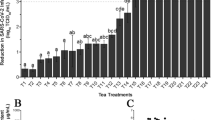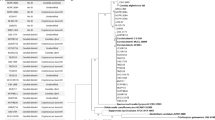Abstract
Pathogenic strains of Acanthamoeba genus are the causative agents of fatal granulomatous amoebic encephalitis and a serious sight-threatening infection of the eye known as Acanthamoeba keratitis. In a previous study, Acanthamoeba strains were isolated from nasal swabs collected from healthy individuals in Peru. In the present study, the pathogenic potential of the isolated strains was established based on temperature and osmotolerance assays as well as the secretion rate of extracellular proteases. Based on these experiments, four strains that showed the highest pathogenic potential were selected for sensitivity assays against two molecules (voriconazole and chlorhexidine) which are currently used for the treatment of Acanthamoeba infections. After performing sensitivity and activity assays, it was found that both drugs were active against the tested strains. However, voriconazole showed higher activity against the studied strains compared to chlorhexidine. Therefore, voriconazole should be established as a first-line treatment against Acanthamoeba infections at least in the studied region of Peru.

Similar content being viewed by others
References
Arce VR, Asato HC (1979) Encefalitis por Acanthamoeba castellani. Diagnostico 3:25–27
Arnalich-Montiel F, Martín-Navarro CM, Alió JL, López-Vélez R, Martínez-Carretero E, Valladares B, Piñero JE, Lorenzo-Morales J (2012) Successful monitoring and treatment of intraocular dissemination of Acanthamoeba. Arch Ophthalmol 130:1474–1475
Bang S, Edell E, Eghrari AO, Gottsch JD (2010) Treatment with voriconazole in 3 eyes with resistant Acanthamoeba keratitis. Am J Ophthalmol 149:66–69
Cabello-Vílchez AM, Martín-Navarro CM, López-Arencibia A, Reyes-Batlle M, González AC, Guerra H, Gotuzzo E, Valladares B, Piñero JE, Lorenzo-Morales J (2013) Genotyping of potentially pathogenic Acanthamoeba strains isolated from nasal swabs of healthy individuals in Peru. Acta Trop. doi:10.1016/j.actatropica.2013.10.006 [Epub ahead of print]
Derda M, Hadas E, Thiem B (2009) Plant extracts as natural amoebicidal agents. Parasitol Res 104:705–708
El-Sayed NM, Ismail KA, Ahmed SA, Hetta MH (2011) In vitro amoebicidal activity of ethanol extracts of Arachis hypogaea L., Curcuma longa L. and Pancratium maritimum L. on Acanthamoeba castellanii cysts. Parasitol Res 110:1985–1992
Galarza C, Ramos W, Gutiérrez EL, Ronceros G, Teran M, Uribe M, Navincopa M, Ortega-Loayza AG (2009) Cutaneous acanthamebiasis infection in immunocompetent and immunocompromised patients. Int J Dermatol 48:1324–1329
Gotuzzo E, Bravo F, Cabrera J (2003) Amebas de vida Livre- Enfase na Infeccao por Balamuthia mandrillaris. Cimerman S, Cimerman B. Medicina Tropical- Atheneu, En, pp 59–64
Khan NA (2003) Pathogenesis of Acanthamoeba infections. Microb Pathog 34:277–285
Khan NA (2006) Acanthamoeba: biology and increasing importance in human health. FEMS Microbiol Rev 30:564–595
Khan NA, Jarroll EL, Panjwani N, Cao Z, Paget TA (2000) Proteases as markers for differentiation of pathogenic and nonpathogenic species of Acanthamoeba. J Clin Microbiol 38:2858–2861
Lim N, God D, Bunce C, Xing W, Fraenkel G, Poole TRG, Ficker L (2008) Comparison of polyhexamethylene biguanide and chlorhexidine as monotherapy agents in the treatment of Acanthamoeba keratitis. Am J Ophthalmol 145:130–135
Lorenzo-Morales J, Ortega-Rivas A, Foronda P, Abreu-Acosta N, Ballart D, Martínez E, Valladares B (2005) RNA interference (RNAi) for the silencing of extracellular serine proteases genes in Acanthamoeba: molecular analysis and effect on pathogenecity. Mol Biochem Parasitol 144:10–15
Lorenzo-Morales J, Kliescikova J, Martinez-Carretero E, De Pablos LM, Profotova B, Nohynkova E, Osuna A, Valladares B (2008) Glycogen phosphorylase in Acanthamoeba spp.: determining the role of the enzyme during the encystment process using RNA interference. Eukaryot Cell 7:509–517
Lorenzo-Morales J, Martín-Navarro CM, López-Arencibia A, Arnalich-Montiel F, Piñero JE, Valladares B (2013) Acanthamoeba keratitis: an emerging disease gathering importance worldwide? Trends Parasitol 29:181–187
Maghsood AH, Sissons J, Rezaian M, Nolder D, Warhurst D, Khan NA (2005) Acanthamoeba genotype T4 from the UK and Iran and isolation of the T2 genotype from clinical isolates. J Med Microbiol 54:755–759
Malatyali E, Tepe B, Degerli S, Berk S, Akpulat HA (2012) In vitro amoebicidal activity of four Peucedanum species on Acanthamoeba castellanii cysts and trophozoites. Parasitol Res 110:167–174
Marciano-Cabral F, Cabral G (2003) Acanthamoeba spp. as agents of disease in humans. Clin Microbiol Rev 16:273–307
Martinez AJ (1980) Is Acanthamoeba encephalitis an opportunistic infection? Neurology 30:567.574
Martín-Navarro CM, Lorenzo-Morales J, Cabrera-Serra MG, Rancel F, Coronado- Alvarez NM, Piñero JE, Valladares B (2008) The potential pathogenicity of chlorhexidine-sensitive Acanthamoeba strains isolated from contact lens cases from asymptomatic individuals in Tenerife, Canary Islands, Spain. J Med Microbiol 57:1399–1404
Martín-Navarro CM, López-Arencibia A, Arnalich-Montiel F, Valladares B, Piñero JE, Lorenzo-Morales J (2013) Evaluation of the in vitro activity of commercially available moxifloxacin and voriconazole eye-drops against clinical strains of Acanthamoeba. Graefes Arch Clin Exp Ophthalmol 251:2111–2117
Mehdi H, Garg HS, Garg NK, Bhakuni DS (1998) Sterols of Acanthamoeba culbertsoni strain A-1. Steroids 51:551–558
Moereels H, Leysen JE (1993) Novel computational model for the interaction of dopamine with the D2 receptor. Recept Channels 1(2):89–97
Na BK, Kim JC, Song CY (2001) Characterization and pathogenetic role of proteinase from Acanthamoeba castellanii. Microb Pathog 30:39–48
Narváez J (1996) Encefalitis amebiana primaria granulomatosa. Diagnostico 35:13–19
Niyyati M, Lorenzo-Morales J, Rahimi F, Motevalli-Haghi A, Martín-Navarro CM, Farnia S, Valladares B, Rezaeian M (2009) Isolation and genotyping of potentially pathogenic Acanthamoeba strains from dust sources in Iran. Trans R Soc Trop Med Hyg 103:425–427
Polat ZA, Tepe B, Vural A (2007) In vitro effectiveness of Thymus sipyleus subsp. sipyleus var. sipyleus on Acanthamoeba castellanii and its cytotoxic potential on corneal cells. Parasitol Res 101:1551–1555
Qvarnstrom Y, Nerad TA, Visvesvara GS (2013) Characterization of a new pathogenic Acanthamoeba species, A. byersi n. sp., Isolated from a human with fatal amoebic encephalitis. J Eukaryot Microbiol 60:626–633
Ródio C, Vianna DR, Kowalski KP, Panatieri LF, von Poser G, Rott MB (2008) In vitro evaluation of the amebicidal activity of Pterocaulon polystachyum (Asteraceae) against trophozoites of Acanthamoeba castellanii. Parasitol Res 104:191–194
Schuster FL, Visvesvara GS (2004) Opportunistic amoebae: challenges in prophylaxis and treatment. Drug Resist Updat 7:41–51
Schuster FL, Guglielmo BJ, Visvesvara GS (2006) In-vitro activity of miltefosine and voriconazole on clinical isolates of free-living amebas: Balamuthia mandrillaris, Acanthamoeba spp., and Naegleria fowleri. J Eukaryot Microbiol 53:121–126
Shoaib HM, Muazzam AG, Mir A, Jung SY, Matin A (2013) Evaluation of inhibitory potential of some selective methanolic plants extracts on biological characteristics of Acanthamoeba castellanii using human corneal epithelial cells in vitro. Parasitol Res 112:1179–1188
Shoff ME, Joslin CE, Tu EY, Kubatko L, Fuerst PA (2008) Efficacy of contact lens systems against recent clinical and tap water Acanthamoeba isolates. Cornea 27:713–719
Siddiqui R, Khan NA (2012) Biology and pathogenesis of Acanthamoeba. Parasitol Vectors 5:6
Sifaoui I, López-Arencibia A, Martín-Navarro CM, Chammem N, Mejri M, Lorenzo- Morales J, Abderabba M, Piñero JE (2013) Activity assessment of Tunisian olive leaf extracts against the trophozoite stage of Acanthamoeba. Parasitol Res 112:2825–2829
Smith FR, Korn ED (1968) 7-Dehydrostigmasterol and ergosterol: the major sterols of an amoeba. J Lipid Res 9:405–408
Walia R, Montoya JG, Visvesvara GS, Booton G, Doyle A (2007) A case of successful treatment of cutaneous Acanthamoeba infection in a lung transplant recipient. Transpl Infect Dis 9:51–54
Acknowledgments
This work was supported by the grants RICET (project no. RD12/0018/0012of the programme of Redes Temáticas de Investigación Cooperativa, FIS), Spanish Ministry of Health, Madrid, Spain and the Project FIS PI10/01298 “Protozoosis emergentes por amebas de vida libre: aislamiento y caracterización molecular, identificación de cepas transportadoras de otros agentes patógenos y búsqueda de quimioterapias efectivas” from the Instituto de Salud Carlos III. IS was funded by an alternating Scholarship from the University of Carthage, Tunisian Ministry of Higher Education and Scientific Research. ALA was funded by a grant “Ayudas del Programa de Formación de Personal Investigador, para la realización de Tesis Doctorales” from the Agencia Canaria de Investigación, Innovación y Sociedad de la Información from the Canary Islands Government. CMMN was supported by a postdoctoral grant from the Fundación Canaria Manuel Morales, La Palma, Canary Islands. JLM was supported by the Ramón y Cajal Subprogramme from the Spanish Ministry of Economy and Competivity RYC-2011-08863.
Author information
Authors and Affiliations
Corresponding author
Rights and permissions
About this article
Cite this article
Cabello-Vílchez, A.M., Martín-Navarro, C.M., López-Arencibia, A. et al. Voriconazole as a first-line treatment against potentially pathogenic Acanthamoeba strains from Peru. Parasitol Res 113, 755–759 (2014). https://doi.org/10.1007/s00436-013-3705-8
Received:
Accepted:
Published:
Issue Date:
DOI: https://doi.org/10.1007/s00436-013-3705-8




